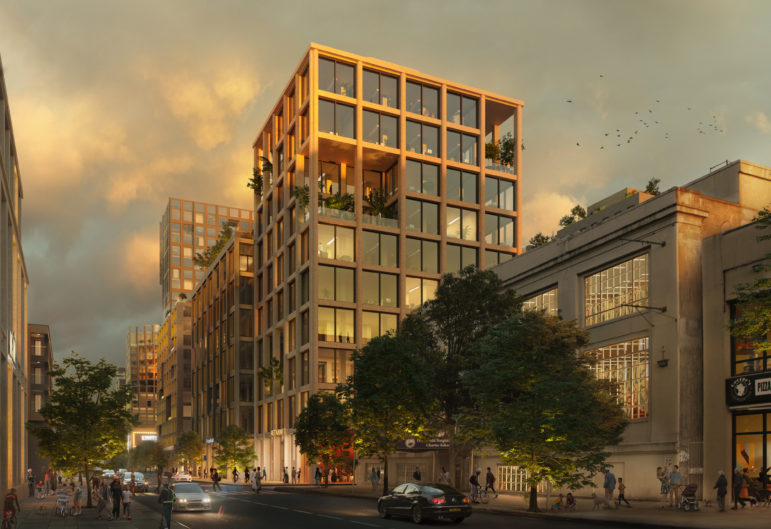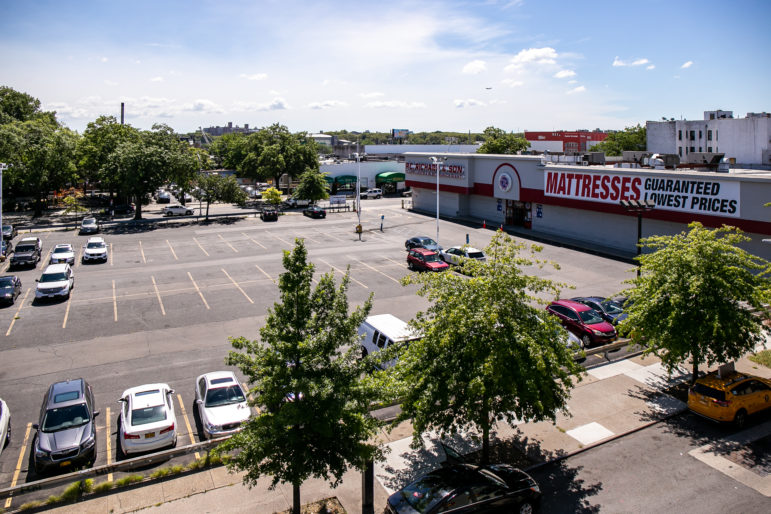The latest version of the Innovation Qns plan features 1,436 income-restricted apartments, around 45 percent of the total. “We have set a new precedent for building affordable housing on private land,” the neighborhood’s Councilmember Julie Won said in prepared remarks ahead of the vote.

Courtesy of the developers
A rendering of the “Innovation QNS” proposal, which would erect at least a dozen towers along a five-block stretch of Astoria.The City Council is poised to approve development of a $2 billion, 3,190-unit complex in an active industrial swath of southern Astoria, after the local councilmember green-lit a new version of the project with hundreds of additional income-restricted apartments than previously proposed.
Councilmember Julie Won announced that she will vote in favor of an application to upzone the manufacturing district ahead of a land use committee vote Monday, paving the way for the massive 12-building project known as Innovation Qns with 1,436 apartments priced for low- and middle-income New Yorkers—up from 711 in the original project proposal. The full City Council will vote next on the project, and councilmembers typically defer to the local lawmakers on land use applications in their district..
“We have set a new precedent for building affordable housing on private land,” Won said in prepared remarks ahead of the vote.
In an interview with City Limits Sunday night, Won hailed the developers’ inclusion of 554 “family-sized” two- and three-bedroom, income-restricted units not included in the initial plan. The new figures mean around 45 percent of the apartments will be income-capped and deemed “affordable.” Of those, 157 apartments will be set aside for people experiencing homelessness, she said.
“Those are significant gains for my community,” Won said. “This is not the best that my community deserves, but it’s the best I could get within a negotiation that is always a compromise for both sides.”
She had earlier demanded that the developer make 55 percent of all apartments “affordable” but said she backed off to preserve as many units as possible for low-income residents. She said the 45 percent threshold will be a benchmark for future negotiations, including plans to upzone Anable Basin, site of the failed Amazon campus plan in neighboring Long Island City.
“I’m here for true affordable housing,” Won said. “This was the most I could do, but it’s a great start.”
Her decision comes after months of intense, and increasingly contentious, negotiations with the developers, as well as Council staff, City Hall officials and union leaders who sought her approval for such a large-scale project on private land, which supporters say will create much-needed new homes during a citywide housing shortage.
But critics of the proposal argued it didn’t offer enough truly affordable units, expressing fears about potential for “secondary displacement”—a disputed concept that new developments leads to higher rents in adjacent buildings—and accelerated gentrification in a part of Astoria where average incomes trail other parts of the neighborhood.
“What they envisioned for this was a fancy Upper East Side kind of neighborhood,” Won said of the developers behind the project and their initial plan. “It’s now truly going to be a mixed-income, affordable community-centered development.”
The development team, composed of the corporations Silverstein Properties, BedRock Real Estate Partners and Kaufman Astoria Studios, first introduced the Innovation Qns plan in 2020, before formally submitting an application to rezone the area from low-rise manufacturing to large-scale residential use in March.
The original proposal included around 2,800 units, with just over 700 deemed “affordable” under the city’s Mandatory Inclusionary Housing (MIH) rules, which force developers to cap rents so that low- and middle-income residents pay no more than 30 percent of their income in a portion of new apartments built in areas that underwent a rezoning. But developers have three options for “affordability” across a range of income levels, with many of the so-called affordable units still far out of reach of many low-income renters.
Won said the latest version of the project features 658 units with rents set for people earning 30 percent of the area median income—currently $28,000 for an individual and $36,000 for a family of three.

Adi Talwar
Looking Southeast from 38th Street in Astoria, part of the area that would be developed under the Innovation QNS plan.The plan would create what amounts to a new neighborhood within the blocks bound by 37th Street to the west, Northern Boulevard to the east, 35th Avenue to the north and 36th Avenue to the south. Several manufacturing businesses currently operate in the area, though many others have been forced to move in recent years after the development team purchased parcels in preparation for a rezoning.
The plan has faced significant backlash. The local community board shot down the proposal in its advisory role, with some members, joined by a variety of community-based organizations, calling for 100 percent “affordable” development. Queens Borough President Donovan Richards also initially opposed the project, demanding the developers cap rents in 50 percent of the apartments.
But Richards later supported the proposal after the development team agreed to limit rents in 40 percent of units. Without rezoning approval, the area could turn into a “truck depot,” he warned, in a reference to the potential fate of a stretch of Harlem that was subject to a failed residential rezoning earlier this year.
Won held out, however, even as Mayor Eric Adams, Speaker Adrienne Adams and a number of influential labor unions backed the plan. She said she would settle for no less than 55 percent “affordability” in the development.
On Sunday, Won told City Limits she was presented with a plan to get to 55 percent, but only if the developers could pursue one of three MIH options that would allow them to set higher rents in the so-called “affordable” apartments.
She said she decided to compromise to preserve the more deeply affordable units, but took a veiled swipe at Richards. The two sparred during a Council hearing on the project last month.
“Those who have auxiliary or advisory roles in the [Universal Land Use Review Process] were making a fuss, going around town, saying, ‘It’s over. Stop negotiating. It’s 40 percent or nothing,’” Won said. “But guess what, that wasn’t true because we got a gain of 336 units of affordable housing because we did not stop negotiating.”
Richards, in turn, had previously accused Won of backtracking on a pledge to support the project at 40 percent affordability. “With more than 63,000 people in shelters, including asylum seekers, we must continue to do everything in our power to both preserve and build affordable housing, especially in communities with little to none of it,” he told the Queens Eagle following a council subcommittee vote on the project earlier this month. “Queens can and must be the borough of yes.”
Project supporters have said the city desperately needs housing for residents of all income-levels amid a serious shortage. A major project like Innovation Qns could help put a dent in the overall need.
For years, residential development has failed to keep pace with population growth, with less than 0.2 units added to the city’s housing stock for every new job created between 2010 and 2018, according to a report by the Citizens Budget Commission.
New York City faces a shortage of available apartments, leading to record-setting rents. But the problem is most dire for low-income New Yorkers: overall apartment vacancy rate for apartments priced below $1,500 is less than 1 percent, according to the city’s latest housing survey.
The full Council will likely vote on the project at a meeting tomorrow.
The project developers did not immediately provide a response when contacted by phone Monday.









4 thoughts on “Won Greenlights 3,200-Unit Astoria Development, Paving Way for Council Approval ”
I can assure everyone that these “affordable” apartments will never exist.
Affordable apartments = Slums of The Future! (NYCHA 2.0)
be aware of the possibility of a bait and switch like whats going on at the atlantic yards, pacific park apartments in brooklyn, the majority of the units are high middle class earners and market rate, 2 new buildings just finishing up over there, and they to most likely will be high AMI earners, atlantic yards apartments was supposed to have a large amount of low income and moderate in come units, plus units for seniors, instead our elected officials stood back and put truly affordable housing in undesirable neighborhoods, so dont be surprised if those units are high middle class and market rate in those Astoria apartments, just like downtown brooklyn so call affordable housing is un affordable so probably and eventually Astoria apartments will be the same
those apartments will be affordable for high middle class and market rate earners, with maybe a small amount 10 units of lowincome